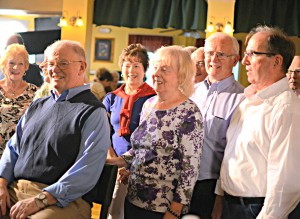The Fireside Room at the Philadelphia Irish Center is a cozily dim little space. There’s a polished wood floor just perfect for set dancing. Off to one side, there is a long bar, a kind of elongated oval, the walls minimally decorated with artifacts like a hurling stick and an old photo of the Philadelphia Emerald Society Pipe Band. Three large television screens broadcast the latest Phillies debacle.
On a typical Saturday morning, this room would be about as bustling as the tomb of Tutankhamun, but on this particular Saturday morning, it’s a different story. A dozen or so of the regulars are propping up the bar, a trio of pipers is playing “Minstrel Boy” and “The Wearin’ of the Green,” and from time to time a few of John Shields’ dancers are dancing. And on a day when the outside temperatures are projected to hit the low 80s, a stack of logs blazes away in the fireplace. The center’s noisy air conditioning is off. Banks of blindingly bright lights illuminate all the dark corners, each one of those corners as neat as the legendary pin. A boom mic hangs over the bar. There are video cameras everywhere.
Perhaps the most obvious anomaly: The Guinness and Smithwick’s tap handles have been unscrewed and put away, and all of the folks at the bar are sipping Sprites or ice water. That’s because a camera crew is getting set to film a commercial for Penn Medicine, and pints of beer wouldn’t be in keeping with a world-renowned medical center’s message of robust health.
The center of attention is Tom Staunton, a reserved, self-effacing man well known to the Irish Center, seated with a couple of friends at a high-top table along the dance floor. His job at that moment is to do what comes naturally–chat with his friends, share jokes, have a laugh. Welcome the waitress when she arrives with a plate of beef and potatoes. Between takes, the three friends are visited by a makeup artist, who gently dabs away patches of perspiration along their foreheads and the tips of their noses. Three takes in all before the camera crew is satisfied.
The shoot began before 10 in the morning, and wrapped up around 4 in the afternoon. And all for a commercial that will last a minute on television.
The ad will draw public attention to a revolutionary new procedure at Penn for the treatment of the common but potentially lethal heart flutter known as atrial fibrillation, a condition that leaves patients with a high risk of stroke. It’s called the Lariat® procedure, and Staunton was the first one in the state to get it. Dr. Daniel McCormick performed the operation.
Staunton is happy to sing the procedure’s praises, no matter how many takes. “It really works,” he says. And that’s not just an advertising tagline. Staunton believes the Lariat procedure changed his life for the better, and he’s deeply grateful.
Staunton was diagnosed with AFib in 2012. The drug of choice for atrial fibrillation is warfarin—an anticoagulant, or blood thinner. But it’s by no means a happy choice. Management of the condition with warfarin is often extremely difficult. Doctors need to strike a balance—enough warfarin to help, but not so much that it hurts. Like most, if not all, drugs, warfarin is not without its risks. A recent Penn Medicine blog post sums it up:
While there will always be a need for blood thinners in medicine, the truth is, their effectiveness is precisely what makes them so dangerous. Warfarin, the most commonly used … is also used to poison rats and mice. Its anti-clotting properties produce death through internal hemorrhaging—a trait you want to control rodent populations, not your AFib.
Staunton can vouch for the difficulty of warfarin therapy, which requires constant monitoring. “One week it was OK,” he says, “and the next week it wasn’t.”
The Lariat procedure is a new way to treat AFib without the risks and difficulty of warfarin. There’s a long explanation of the procedure, but the short of it is that the surgeon, using minimally invasive techniques, creates a kind of lasso-shaped suture and cinches off the section of the heart responsible for the flutter, and that section eventually is absorbed into the body. The good news: No more warfarin.
Though Staunton is not accustomed to the limelight, he believes a few hours of fuss is well worth it. “If they use me here in this way, maybe it will help other people to know about this procedure and have it done.”
For his part, Irish Center manager Tom Walsh says, the Irish Center was happy to serve as center stage—although he confesses, he didn’t know what to expect. He says the commercial’s producer initially called him and Staunton some time ago to pitch the idea. “After that, I carried the conversation forward as far as people to line up as participants. The producer came around here yesterday (Friday) for two hours. And he asked me: ‘Do you know what you’re in for here?’ And I said, no, but I’ll keep an open mind.”
The commercial will air on local television around mid-October.

